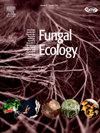植物和群落尺度下卵菌群落的气候驱动因素
IF 2.2
3区 环境科学与生态学
Q3 ECOLOGY
引用次数: 0
摘要
陆生卵菌是生物多样性中一个重要的、经常被忽视的组成部分,但它们对气候变化的潜在反应在很大程度上仍然未知。我们利用DNA元条形码技术,在地上和地下的植物群落和焦点树尺度上,对不同海拔(27-650 m)和降水(735-1905 mm yr - 1)的卵菌群落进行了量化。Aplanopsis、Globisporangium、Pythium、Phytophthora和Peronospora占主导地位,地上和地下基质分化强烈。群落样品中卵菌数量和物种丰富度随海拔升高而下降,但焦点乔木样品中卵菌数量和物种丰富度随海拔升高而下降,而群落组成受基质、海拔和降水的强烈影响。在当前的气候趋势下,我们的研究结果表明,高海拔地区的卵菌群落可能会发生很大的组成变化,包括到2100年左右卵菌物种数量增加3.5倍,这可能对植物群落结构和健康产生重大影响。本文章由计算机程序翻译,如有差异,请以英文原文为准。
Climatic drivers of oomycete communities at plant and community scales
Terrestrial oomycetes are an important, often-overlooked component of biodiversity, but their potential response to climate change remains largely unknown. We quantified oomycete communities across elevation (27–650 m) and precipitation (735–1905 mm yr−1) at both a plant community and focal tree scale in above- and below-ground substrates using DNA metabarcoding. Aplanopsis, Globisporangium, Pythium, Phytophthora, and Peronospora dominated communities, with strong differentiation between above- and below-ground substrates. Oomycete presence and species richness declined with elevation in community samples, but not in focal tree samples, while community composition was strongly affected by substrate, elevation and precipitation in all sample types. Under current climate trends, our findings suggest oomycete communities at higher elevations may undergo large shifts in composition, including a 3.5 × increase in the number of oomycete species by around 2100, which could have significant consequences for plant community structure and health.
求助全文
通过发布文献求助,成功后即可免费获取论文全文。
去求助
来源期刊

Fungal Ecology
环境科学-生态学
CiteScore
5.80
自引率
3.40%
发文量
51
审稿时长
3 months
期刊介绍:
Fungal Ecology publishes investigations into all aspects of fungal ecology, including the following (not exclusive): population dynamics; adaptation; evolution; role in ecosystem functioning, nutrient cycling, decomposition, carbon allocation; ecophysiology; intra- and inter-specific mycelial interactions, fungus-plant (pathogens, mycorrhizas, lichens, endophytes), fungus-invertebrate and fungus-microbe interaction; genomics and (evolutionary) genetics; conservation and biodiversity; remote sensing; bioremediation and biodegradation; quantitative and computational aspects - modelling, indicators, complexity, informatics. The usual prerequisites for publication will be originality, clarity, and significance as relevant to a better understanding of the ecology of fungi.
 求助内容:
求助内容: 应助结果提醒方式:
应助结果提醒方式:


